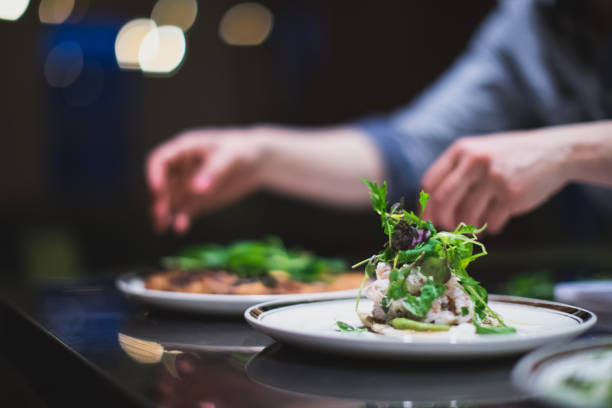Culinary Alchemy: Transforming Humble Ingredients
Unlock the secrets of culinary alchemy and turn ordinary ingredients into extraordinary dishes. From kitchen scraps to forgotten pantry staples, discover innovative techniques that elevate simple components into gourmet masterpieces. Join us on a journey of flavor transformation and creative cooking.

Flavor Alchemy: Unexpected Pairings
The true magic of culinary alchemy lies in the unexpected flavor combinations that can elevate a dish from ordinary to extraordinary. By challenging traditional flavor pairings, we open up a world of new taste experiences. Consider the surprising harmony of strawberries and black pepper, or the intriguing combination of chocolate and olive oil. These unconventional pairings work by balancing contrasting flavors or enhancing complementary notes. For instance, the sweetness of strawberries is beautifully offset by the subtle heat of black pepper, creating a complex and layered flavor profile. Similarly, the richness of chocolate is elevated by the fruity notes of high-quality olive oil, resulting in a sophisticated dessert experience. To master flavor alchemy, it’s essential to understand the basic taste categories - sweet, sour, salty, bitter, and umami - and how they interact. Experimenting with different combinations across these categories can lead to truly innovative and memorable dishes that challenge and delight the palate.
Texture Transformation Techniques
Texture plays a crucial role in our perception of food, and mastering texture transformation can elevate even the simplest ingredients. One innovative technique is spherification, popularized by molecular gastronomy, which turns liquids into gel-like spheres that burst in the mouth. This can be applied to transform humble ingredients like olive oil or fruit juices into elegant garnishes. Another method is dehydration, which concentrates flavors while altering texture. For example, dehydrated watermelon takes on a chewy, intensely flavored quality that’s reminiscent of candy. Sous vide cooking, typically associated with proteins, can also be used to manipulate the texture of vegetables, resulting in perfectly tender yet crisp produce. Even simple techniques like pickling or fermenting can dramatically change the texture and flavor profile of ingredients, adding depth and complexity to dishes. By experimenting with these texture transformation techniques, chefs can create multi-dimensional eating experiences that engage all the senses, turning ordinary ingredients into culinary works of art.
The Power of Presentation
In culinary alchemy, presentation is just as important as taste and texture. The visual appeal of a dish can transform the dining experience, elevating simple ingredients into a feast for the eyes. One innovative approach is deconstruction, where familiar dishes are broken down into their component parts and reassembled in creative ways. For example, a classic Caesar salad could be reimagined with romaine lettuce foam, parmesan crisps, and anchovy powder. Another technique is the use of edible “paint” made from pureed fruits or vegetables, allowing chefs to create stunning, colorful designs on the plate. Even humble ingredients can be elevated through careful plating techniques, such as using tweezers to precisely place micro herbs or edible flowers. The use of unconventional serving vessels, like hollowed-out fruits or custom-made ceramics, can also add an element of surprise and delight to the presentation. By paying attention to color, texture, and composition, chefs can transform even the most basic ingredients into visually stunning creations that engage diners before they’ve taken their first bite.
From Scraps to Stars: Kitchen Waste Reinvented
One of the most exciting frontiers in culinary alchemy is the reimagining of kitchen scraps and byproducts. This approach not only reduces waste but also challenges chefs to find creative uses for often-overlooked ingredients. Vegetable peels, for instance, can be transformed into crispy chips or infused into oils and vinegars for added flavor. Fruit scraps can be fermented into vinegars or used to create homemade pectin for jams and jellies. Even coffee grounds can find new life as a flavorful rub for meats or as an ingredient in rich, chocolatey desserts. Whey, a byproduct of cheese-making, can be used to tenderize meats or as a base for refreshing beverages. By viewing kitchen waste as a valuable resource rather than trash, chefs can create unique dishes that tell a story of sustainability and innovation. This approach not only benefits the environment but also pushes the boundaries of culinary creativity, resulting in dishes that are both eco-friendly and deliciously unexpected.
Creative Culinary Alchemy Tips
-
Experiment with sous vide cooking for fruits to intensify flavors without losing texture
-
Try using a smoking gun to add depth to unexpected ingredients like butter or cocktails
-
Explore fermentation to transform simple vegetables into complex, probiotic-rich foods
-
Use liquid nitrogen for instant freezing, creating unique textures in desserts and cocktails
-
Incorporate edible flowers not just for garnish, but as integral flavor components in dishes
-
Experiment with different types of salts to add complexity to both savory and sweet dishes
-
Try using a culinary centrifuge to separate ingredients and create clear consommés
-
Explore hydrocolloids to create unique textures like fluid gels or “caviar” from any liquid
In conclusion, culinary alchemy is about more than just cooking; it’s a mindset that encourages creativity, sustainability, and innovation in the kitchen. By reimagining humble ingredients, exploring unexpected flavor combinations, and embracing new techniques, we can transform ordinary meals into extraordinary culinary experiences. As we continue to push the boundaries of what’s possible in the kitchen, we not only create delicious food but also contribute to a more sustainable and exciting culinary future. So, the next time you’re in the kitchen, don’t be afraid to experiment, play with your food, and unleash your inner culinary alchemist.





